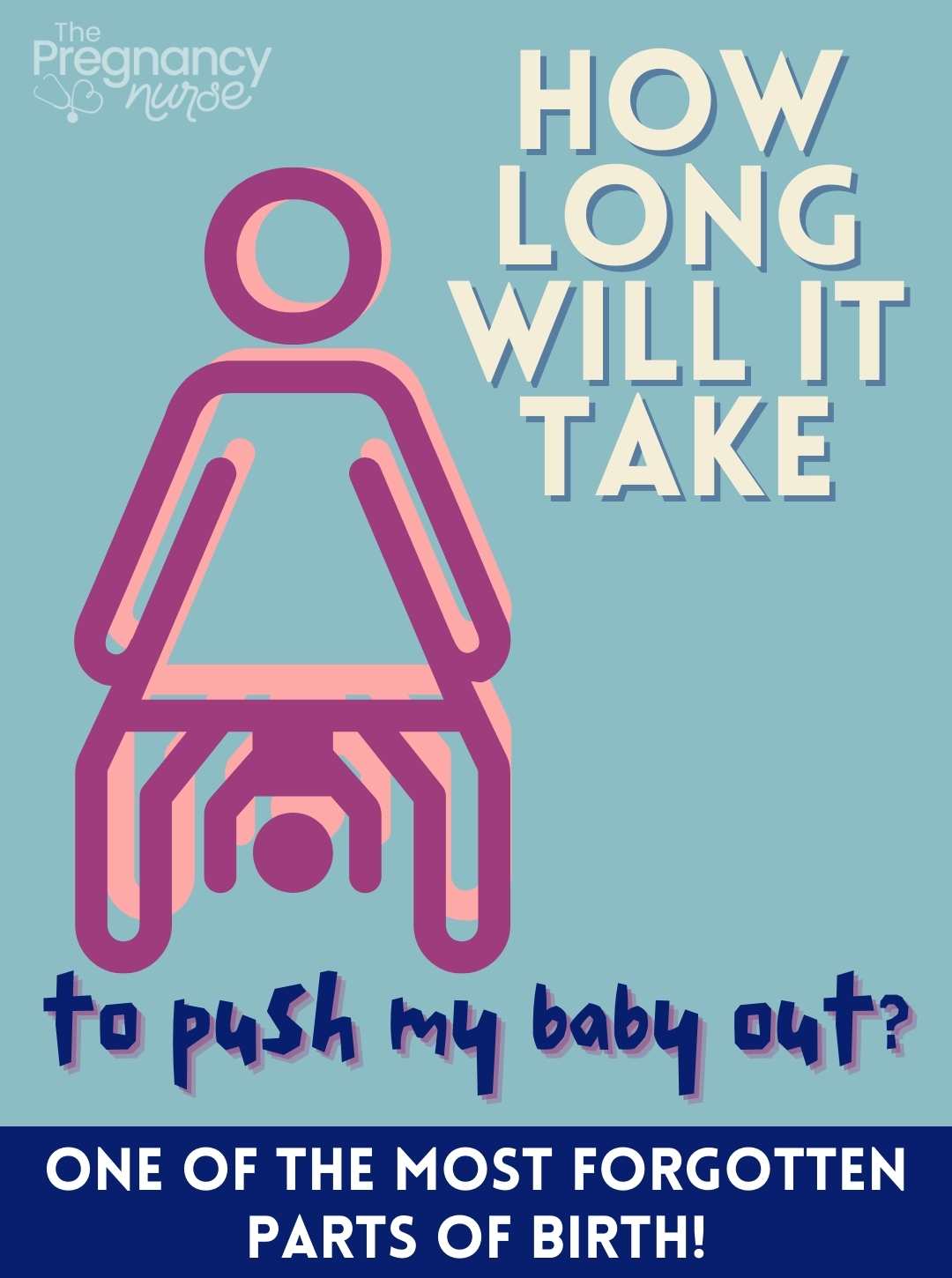The third stage of labor (the pushing stage) can be brutal, because expectations are that it will be easy. But, how long does it take to push a baby out of the birth canal — and how exactly DO you push out a baby?
Hi, I’m Hilary — The Pregnancy Nurse. Pushing seems like one of the great mysteries of labor and I am excited to share with you some information on it today. I have been a nurse since 1997 and I have had 20 years in labor and delivery, so I have experienced this third stage maybe even a thousand times.
If you are looking for more information on labor and delivery, do not miss my online childbirth course. It details everything from the admission process, pushing, delivery. I like to call it from bump to basinette — but we even continue information through those first few months of motherhood. Don’t miss it!
The Third Stage of Labor
First off, which is the third phase and how does it fit in?
Four Phases of Labor
FYI, phases and stages of labor are used to mean the same thing:
Phase 1: Latent phase, early labor (the definition of this phase varies from a closed cervix to about 3-6 cm). The first stage of labor is often the longest (especially in first time moms). This normally involves more mild contracts, irregular contractions that aren’t as frequent.
Phase 2: Active Labor — from 3-6 cm until 10 cm — for most people the second stage of labour is while you’re at the hospital until you being pushing (unless you are induced).
Phase 3: Pushing stage — this phase ends with the vaginal delivery of the baby
Phase 4: Delivery of the placenta
Keep in mind that besides phase 4 — it sort of “varies” as when you move from one to another. It’s not something that medical staff really charts, just gives you a better idea of how labor will progress.
What happens during the third phase of labor?
You push out the baby.
But, mostly you’re pushing the baby’s head further into the birth canal.
The Second stage is where your uterus pushes the baby about as far as it can — which is when you will engage with pushing.
You uterus has done the vast majority of the work up until this point. But, your contractions alone won’t be enough to get the baby out (at least in most cases).
If you want to look at it in bodily terms — it’s like having bowel movement..
Your body most often won’t get poop out on its own. You’re required to push a bit at the end to have it exit your body. Same idea with the baby. And yes, I have a post on avoiding pooping at delivery.
What is “laboring down”?
Many practitioners prefer that moms “labor down”, especially if they have a comfortable epidural.
This means that we continue to let your uterus push the baby down as much as it can on its own and then you engage with pushing once it’s a bit lower.
How low is the baby?
Medical staff measures how low the baby’s head is by “station” (I have a whole post on my sister site about vaginal exams) — that means how high or low the baby’s head is in comparison to the ischial spines (basically your bum bones).

It would be the hope that by the time your cerivix is fully dilated (10 cm) — your baby would be at least 0 station if not plus 2 or even three.
If your baby is still high when you are fully dilated, I would expect your nurse to be turning you and using positioning to help baby find its way into your pelvis.
How do you push out a baby?
There isn’t really a reason to PRACTICE (because having a BM gives us all the practice we need — it’s all the same muscles). However, you REALLY don’t want to practice pushing (beyond what’s required by your body) until you’re closer to your due date.
You bear down and push, just like you are pooping. Yup, that analogy is pretty similar to the whole process.
Most people without epidural anesthesia have a strong urge to push as the baby’s head lowers into the pelvis. They may feel a lot of pressure, and often it feels GOOD to push at that point.
The Routine of pushing:
- Take a big deep breath in
- Bear down for as long as you can (some nurses count to ten) with abdominal muscles
- Blow that air out
Rinse and repeat.
** FYI, most often pain relief isn’t offered during the pushign stage because IV pain medication might make the baby tired. You can sometimes still get an epidural at this point though.
Open Glottal vs Closed Glottal Pushing
Studies show that women do better with “open glottal pushing” — problem is, that is studies. I find that each mom has to kind of get into her zone of pushing.
What is Open Glottal Pushing
It is where you allow air (and sound) to escape your mouth while you push.
The main problem I have had with this is that women just SCREAM rather than push.
And while that is 100% their right to scream, it isn’t effective in pushing out the baby.
I have found that some moaning can be helpful to engage your lower abs and push the baby better. More low sounds vs the high pitched GET THIS OUT type feeling.
But you’ll find the best ways often are what feels best to you. It’s a good idea for pregnant women to try a few different ways!
How long does it take to push out a first baby?
I read one of the articles on pushing and said it was the “easiest and simple phase of labor”.
Which is an absolute lie.
I wonder who the heck wrote that article.
Average time of pushing on your first baby is 2 hours. It’s a long time (and it probably feels like an even longer time).
That’s the AVERAGE time. Meaning sometimes pregnatn women push for 3 hours, and sometimes just one.
Why does it take so long to push out a baby?
Well, you have bones and tissue that has been that way since you were born.
Baby’s head has to mould (many babies are born with a “conehead” as bones shift to help baby come out — all of this is normal and babies are built to do that safely).
Sometimes pregnant people aren’t pushing in the right spot. They push in their face vs their bottom.
Remember that pushing can be LONG. It’s really stretching those tissues.
Things that lessen pushing time:
A low fetal station
As we talked before, if baby is lower in the pelvis, it stands to reason that moms won’t push as long (as they don’t have as far to go)
Laboring Down
As laboring down will often bring baby lower, it will also lessen pushing time (this doesn’t always work — and I would encourage a lot of movement as you use this strategy — I like to turn my patients at least every 30 minutes if we are laboring down).
Changing Positioning
Change positions! You can push on your side, you can change your hand holds, you can try hands and knees or other things. There are lots of different positions you can try.
By encouraging your nurse to think outside the box (and you willing to put in the effort too) it might help your baby find a sweet spot and come down easier. Also, if the baby’s umbilical cord is in a weird spot (making a poor fetal heart rate tracing), moving can help it slip into a better spot.
Often when you try a few things, you’ll find a comfortable position you like (and that’s often the one you push the best in).
This all being said, a lot of patients are not good about helping us help you to move. If you lay there like a lump of wood, the nurse will be less likely to change your position and help you push that way.
Pro Tip: Birth partners or a family member can help us position you best for pushing. It helps them feel involved, and it helps you increase your movement!
You have to remember you’ll only push that baby out once, but we have to keep doing this day in and day out and preserve our backs for our career.
Putting something about labor movement on your birth plan can be very helpful to tell the staff that you’re a team in helping your baby out!
Lowering the Epidural
The Epidural is similar to your IV medication as it slowly drips into your back. If you are so numb you can’t feel a thing, often we will lower the pain medication to help you push more effectively.
Yes, you will likely feel some pressure and some pain, but it will also allow your body some feedback to push more effectively.
Of course, there are also other things a smaller baby’s head, or a smaller baby in general — but the things above are things we have more control over.
Best tips for pushing:
- Curl up around your baby vs flexing your back and arching your back
- Pull your own legs towards your body, it puts you in a good position to push (again curling around that baby)
- Push your lower back into the bed as you push
- Keep your pelvis relaxed as you push, no kegals!
- Keep arms positioned like you are rowing a boat, elbows off the bed helps (and keeps you rounded around baby)
- Have your partner help you lift your neck so you aren’t straining those muscles.
- If something is bothering you (rather count to ten vs pushing “as long as you can”, or would you like to try a different position) — let your staff know! They can’t read your mind. 🙂
How long does it take to push out a second baby?
Not as long. Most often.
However, if baby is much larger than the first, it can take a while (my 2nd baby was about 1.5 pounds larger than my first — so, I pushed for 45 minutes). Or, if it’s been a while your tissues might not be as “open”
Also, this only matters if your first was a vaginal birth. If you had a cesarean section, the birth canal won’t be stretched out.
Why does it take less time to push out your second baby?
Your vaginal wall has stretched open.
Think of it as a giant accordion that has been opened once before. It’s just that simple. First time mothers, the accodian is not streched. 🙂
How long does it take to push out a third or fourth baby?
Each of your subsequent deliveries will likely take a bit less time. Insomuch that I have had to put a ban on laughing in the room so the doctor would have time to get there for the delivery.
When will my doctor get there?
This is one of the most important part of a labor nurse’s training. Learning when to call the health care provider (delivering provider) and health care team so they are not there too long, and are also there to deliver the baby.
Most often, I called your healthcare provider when the head was visible in the vaginal canal without my fingers opening it and when the patient wasn’t pushing.
I can’t tell you how many OB’s have yelled at me for calling them too late or too early. Totally inappropriate, but you have to remember the nurse is always balancing your needs with the doctors.
It is a very important thing that they are there for delivery.
Sadly.
Doctors CAN make a small cut called an episiotomy which can decrease the amount of time you’ll have to push, but most try to avoid it (and the patients prefer that).
Pushing Out a Baby FAQ’s
Then it breaks. From the minute you get to the hospital, they are prepared for fluids coming out of your vagina. Not a big deal for those nurses.
Yes, some babies don’t progress into the birth canal, and a cesarean section might be necessary in those cases (although it’s rare).
You sure can. Sometimes contractions feel less (or less painful) once you start to push.
Nope, most people feel better once they’re able to push.
They are rare, but I have seen it. Be sure to talk with your provider if you think you have one that might be an issue.
So, that’s the third stage of labour. It ends with the baby’s birth, or delivery of the baby.
It is not the simplest or fastest phase of labor.
That’s the 4th stage, at least we hope. 🙂
Remember, after you push out the baby, there’s still a lot that happens. Most often there’s delayed cord clamping and baby goes on your chest for some skin to skin contact. If you’re interested in the WHOLE process of labor be sure to check out The Online Prenatal Class for Couples that covers the WHOLE thing (bump to bassinette in detail).













 Contractions on The Monitor But You’re Not Feeling Them: What does that mean?
Contractions on The Monitor But You’re Not Feeling Them: What does that mean?

[…] Phase 3: Pushing/Delivery of the baby >> I have a whole post on the pushing phase of labor. […]